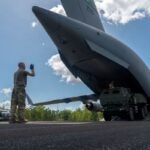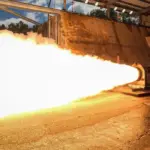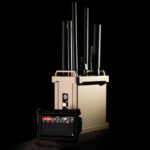
By Dr. Morteza Gharib, Founder of Soaring Technologies.
The future of warfare isn’t just about advanced weaponry; it’s about rapidly adapting to the drone revolution that is fundamentally reshaping battlefields. Recent conflicts—from Ukraine’s innovative defense against a larger aggressor to operations across the Middle East and other far-flung global hotspots—prove that small, intelligent drones can punch far above their weight. These unmanned systems are disrupting enemy command and control, halting large-scale ground invasions, providing critical real-time intelligence, and, most profoundly, transforming frontline logistics.
The U.S. Department of Defense is finally embracing this new reality. The landmark July 10, 2025 Pentagon memorandum titled “Unleashing U.S. Military Drone Dominance,” mandating the rapid proliferation of low-cost, expendable drones across every combat unit signals a crucial shift. This directive moves the U.S. away from a legacy reliance on legacy acquisitions, and costly platforms toward agile, distributed, and frontline-driven innovation.
This change is long overdue. It demands we fundamentally rethink not just the quantity of drones we build but the capability of the drones, and critically, how fast we can get them into the fight.
Historically, ideas of drones have conjured thoughts of high-altitude surveillance or precision strikes from single-purpose UAS like Reapers and Predators. While these continue to serve a critical purpose, the real game-changer for ground forces today is a multi-role drone with a foundation on frontline logistics: getting vital supplies, from medical kits to ammunition and water, directly to soldiers who need them, precisely when they need them, and without unnecessary risk. Additional essential capabilities include communications, surveillance and reconnaissance, and kinetic strike.
Built for Every Mission That Matters
Today’s battlefield doesn’t wait—and neither should our warfighters. Whether it’s a platoon pinned down without ammo, a wounded soldier needing medical supplies, or a blackout zone that needs eyes and comms, one versatile, rugged system should be able to answer every call. This is what drone dominance truly means.
And that’s exactly what’s being built: a medium-lift workhorses designed for the warfighter, not the showroom. These drones leverage modular payloads and fixed-lift stability to resupply, relay comms, gather ISR, deliver precision effects, or even support medevac—all without swapping airframes.
Picture a drone that can carry 50 to 60 pounds of ammo, water, or even a kinetic payload through contested airspace—then turn around and serve as a flying node in a denied comms environment. Its battle-hardened aluminum frame, smart self-correcting flight software, and rapid deployment mean two soldiers can launch it in seconds, from almost anywhere, even after it’s taken a hit.
Such flexibility is paramount in dynamic combat environments. Today’s UAS must be designed for rapid re-tasking, allowing drones to switch missions on the fly—from critical resupply to communications relay or immediate reconnaissance—enabling commanders to adapt rapidly to fast-changing battlefield needs with existing assets.
The Pentagon’s new emphasis on drone proliferation directly reflects lessons learned from Ukraine and other modern conflicts: platoon level, AI-enabled smart drones can decisively outmaneuver massive armies and legacy hardware. The strategic imperative isn’t simply about acquiring more drones; it’s about deploying the right drones. We can’t afford to wait years for prototypes to transition to programs of record; the technology is here now, and this mandate ensures the defense industrial base delivers speed, adaptability, and survivability for decisive advantages at the tactical edge.
Beyond Combat: Humanitarian and Disaster Relief
Beyond their crucial military applications, multi-modal drone technology also has dual-use potential for humanitarian aid and disaster relief. Medium-lift drones can rapidly deploy communication antennas to create local Wi-Fi networks in disaster zones where critical infrastructure has been destroyed by earthquakes, fires, or even deliberate attacks. Conventional assets like helicopters often cannot perform this task as effectively or quickly in complex, debris- strewn environments.
Imagine firefighters or first responders immediately regaining vital connectivity through airborne Wi-Fi platforms deployed by rapidly launched, agile, rugged drones. This innovation isn’t a sudden leap; it culminates years of foundational, cross-disciplinary research at institutions like Caltech, where advanced aerodynamics, robust software control, and bio-inspired designs converged. It is the combination of cutting-edge academic rigor with battlefield-driven user needs that truly enables us to deliver unmanned platforms that are operationally transformative.
The Urgency of Now
Achieving drone dominance, a clear strategic imperative for national security, demands more than technological advancement alone. It requires a parallel cultural transformation within the Department of Defense. This shift must actively embrace innovation-first procurement, maximizing efficiencies, streamlining notoriously slow acquisition processes, and empower frontline commanders with the authority and resources to deploy and refine these critical systems rapidly.
We must prioritize building drones that are flexible and easily controlled and updated—designed from the outset with the soldier’s reality in mind. Real battlefield advantage comes when troops can use drones as an autonomous augmentation to their regular tasks. They must be able to reconfigure payloads on demand, push software updates instantly to adapt to new threats, and keep flying even after battle damage. That’s the future being pioneered: not exotic, niche weapons, but reliable, responsive tools that deliver precisely what’s needed, when it’s needed, in the most challenging environments and at scale.
The battlefield demands urgency, and the nation’s security cannot be held back by red tape. Industry is ready. The Department has signaled it’s ready. The only question is whether they will put taxpayer money toward single use drones or the multi-mission drones that the warfighters demand for mission success.
Morteza Gharib is the Hans W. Liepmann Professor of Aeronautics and Medical Engineering at Caltech and Director, Center for Autonomous Systems and Technologies, in addition to Founder of Soaring Technologies.

Are you a Defense Daily reader with a thought-provoking opinion on a defense issue? We want to hear from you.
- We welcome submissions of opinion articles on national security, defense spending, weapons systems and related areas.
- We welcome submissions from lawmakers, administration officials, industry representatives, military officials, academics, think tank experts, congressional candidates, international experts and others on issues important to the national defense community.
- We welcome a diverse range of opinions all along the political spectrum.
- Email: editor@DefenseOpinion.com













